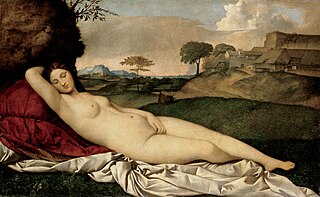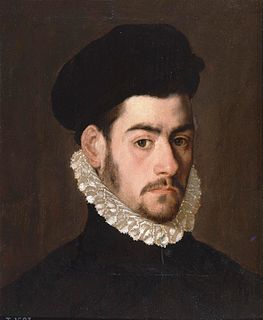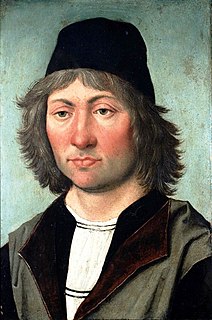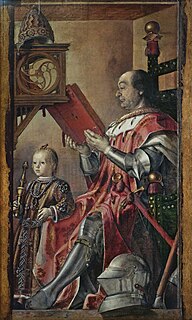
Simancas is a town and municipality of central Spain, located in the province of Valladolid, part of the autonomous community of Castile and León. It is situated approximately 10 km southwest of the provincial capital Valladolid, on the road to Zamora and the right bank of the river Pisuerga.

In art history, "Old Master" refers to any painter of skill who worked in Europe before about 1800, or a painting by such an artist. An "old master print" is an original print made by an artist in the same period. The term "old master drawing" is used in the same way.

The Spanish Golden Age is a period of flourishing in arts and literature in Spain, coinciding with the political rise of the Spanish Empire under the Catholic Monarchs of Spain and the Spanish Habsburgs. The greatest patron of Spanish art and culture during this period was King Philip II (1556-1598), whose royal palace, El Escorial, invited the attention of some of Europe's greatest architects and painters such as El Greco, who infused Spanish art with foreign styles and helped create a uniquely Spanish style of painting.
Alonso is a Spanish name of Germanic origin that is a Galician-Portuguese variant of Adalfuns.

Alonso Sánchez Coello was an Iberian portrait painter of the Spanish and Portuguese Renaissance. He is mainly known for his portrait paintings executed in a style, which combines the objectivity of the Flemish tradition with the sensuality of Venetian painting. He was court painter to Philip II.

Justus van Gent or Joos van Wassenhove was an Early Netherlandish painter who after training and working in Flanders later moved to Italy where he worked for the duke of Urbino. The artist is known for his religious compositions executed in the early Netherlandish idiom and a series of portraits of famous men, which show the influence of early Italian Renaissance painting.

The Spanish Renaissance was a movement in Spain, emerging from the Italian Renaissance in Italy during the 14th century, that spread to Spain during the 15th and 16th centuries.

Alonso González de Berruguete was a Spanish painter, sculptor and architect. He is considered to be the most important sculptor of the Spanish Renaissance, and is known for his emotive sculptures depicting religious ecstasy or torment.

Pedro Berruguete was a Spanish painter whose art is regarded as a transitional style between gothic and Renaissance art. Berruguete most famously created paintings of the first few years of the Inquisition and of religious imagery for Castilian retablos. He is considered by some as the first Renaissance painter in Spain.

Paredes de Nava is a municipality located in the province of Palencia, Castile and León, Spain.

The Museo Nacional de San Gregorio is a museum in Valladolid, Spain, belonging to the Spanish Ministry of Culture. The museum has an extensive collection sculptural ranging from the Middle Ages to the 19th century from Region of Castile's churches that, at 19th-20th c., these were confiscated, and other particular donations, deposits or acquisitions of the state.
The year 1552 in art involved some significant events and new works.
The year 1561 in art involved some significant events and new works.

Felipe Bigarny, also known as Felipe Vigarny, Felipe Biguerny or Felipe de Borgoña, etc. and sometimes referred to as El Borgoñón, was a sculptor born in Burgundy (France) but who made his career in Spain and was one of the leading sculptors of the Spanish Renaissance. He was also an architect.

Blas de Prado, or Del Prado, was a Spanish painter, who was born in the vicinity of Toledo, about 1540, and was a scholar of Alonso Berruguete. There are some of his works in the chapel of St. Blas at Toledo, but they are much injured by time and the dampness of the situation. At Madrid there are also some pictures by this artist, particularly an altar-piece in the church of San Pedro, representing the 'Descent from the Cross,' which is evidently the work of a great master. In the early part of his life Prado was invited to visit the court of the Emperor of Morocco, to paint a portrait of his daughter, and returned to Spain amply rewarded for his labour. Whilst at Fez he painted the portraits of the Princesses of the Harem. He died at Madrid about 1600.

The Portrait of Federico da Montefeltro and His Son Guidobaldo is a painting dating from c. 1475 and housed in the Galleria nazionale delle Marche in Urbino, Italy. There is no consensus on the attribution of the authorship of the painting. The Flemish painter Justus van Gent and the Spanish painter Pedro Berruguete are the main contenders for the honour as both painters are believed to have been working in Urbino at the time the painting was made. The painting is part of a series of 28 portrait paintings of 'uomini famosi' made for the study of Duke of Urbino Federico da Montefeltro.

Herrera is a surname of Spanish origin, from the Latin ferrāria, meaning "iron mine" or "iron works" and also the feminine of Latin ferrārius, "of or pertaining to iron"; or, alternatively, the feminine of Spanish herrero, which also gives the surname Herrero. Variants of the name include Errera, Ferrera and the less common Bherrera. Its equivalent in Portuguese and Galician is Ferreira. Also because of Spanish naming customs, some people are listed here with their family name as their second-to-last name.

The Agustinas Ermitañas Convento Santa Úrsula is an Augustinian convent located in the city of Toledo, in Castile-La Mancha, Spain. It was founded in 1259.














